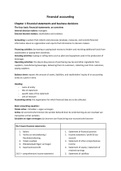Samenvatting
Samenvatting ISE Financial Accounting volledig behandelde stof inclusief hoorcollege aantekeningen
Dit is een zeer uitgebreide samenvatting inclusief alle besproken stof en hoorcollege aantekeningen : H1-H13 + appendix A. Sommige onderwerpen kunnen eventueel dubbel in het document staan, omdat deze meerdere malen zijn besproken in het boek en/of tijdens de colleges. Deze samenvatting beslaat all...
[Meer zien]





